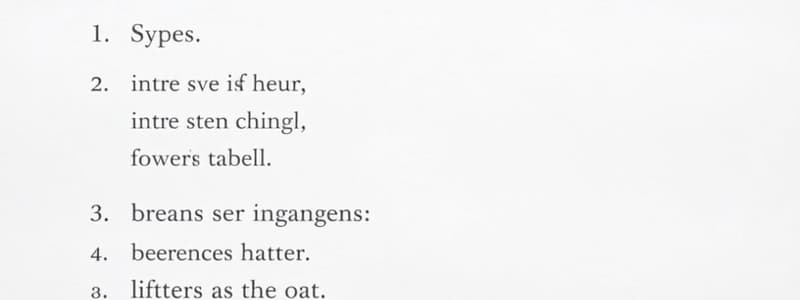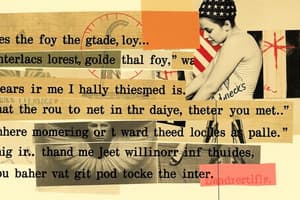Podcast
Questions and Answers
In American English, where are commas and periods placed when ending a sentence with a quotation and using a parenthetical citation?
In American English, where are commas and periods placed when ending a sentence with a quotation and using a parenthetical citation?
- After the closing quotation marks and parenthetical citation. (correct)
- After the closing quotation marks, but before the parenthetical citation.
- Inside the closing quotation marks, after the parenthetical citation.
- Inside the closing quotation marks, before the parenthetical citation.
Which of the following punctuation marks is consistently placed after the closing quotation marks in American English?
Which of the following punctuation marks is consistently placed after the closing quotation marks in American English?
- Periods and question marks.
- Semicolons and question marks. (correct)
- Commas and semicolons.
- Periods and commas.
What is the primary purpose of a friendly letter?
What is the primary purpose of a friendly letter?
- To present a structured argument with the aim of changing someone's mind.
- To update someone known to the writer about their life and maintain contact. (correct)
- To formally persuade a recipient to take a specific action.
- To request charitable donations from businesses in a polite manner.
Which element is typically found in a persuasive letter but NOT explicitly mentioned as a standard component of a friendly letter?
Which element is typically found in a persuasive letter but NOT explicitly mentioned as a standard component of a friendly letter?
A letter to a senator advocating for a change in policy is best categorized as which type of persuasive letter?
A letter to a senator advocating for a change in policy is best categorized as which type of persuasive letter?
Which sentence type is characterized by making a statement and concluding with a period?
Which sentence type is characterized by making a statement and concluding with a period?
Identify the primary function of an imperative sentence.
Identify the primary function of an imperative sentence.
An exclamatory sentence is best defined by its:
An exclamatory sentence is best defined by its:
What is the defining punctuation mark of an interrogative sentence?
What is the defining punctuation mark of an interrogative sentence?
Which of the following is NOT identified as a fundamental characteristic of all sentences?
Which of the following is NOT identified as a fundamental characteristic of all sentences?
A simple sentence is structurally defined as containing:
A simple sentence is structurally defined as containing:
Which of the following sentence structures is exemplified by 'The dog barked loudly and wagged its tail.'?
Which of the following sentence structures is exemplified by 'The dog barked loudly and wagged its tail.'?
In the sentence, 'She is a doctor,' the verb 'is' functions as a:
In the sentence, 'She is a doctor,' the verb 'is' functions as a:
Which sentence demonstrates correct subject-verb agreement with a compound subject that is considered a single unit?
Which sentence demonstrates correct subject-verb agreement with a compound subject that is considered a single unit?
Identify the sentence that correctly uses a possessive noun for a surname.
Identify the sentence that correctly uses a possessive noun for a surname.
Which of the following is an example of a concrete noun?
Which of the following is an example of a concrete noun?
Select the sentence that contains a verb in the past perfect tense.
Select the sentence that contains a verb in the past perfect tense.
Which sentence demonstrates the correct plural form of a noun ending in 'ch'?
Which sentence demonstrates the correct plural form of a noun ending in 'ch'?
Identify the sentence that contains a collective noun.
Identify the sentence that contains a collective noun.
Which sentence demonstrates correct subject-verb agreement when using 'or' to connect plural subjects?
Which sentence demonstrates correct subject-verb agreement when using 'or' to connect plural subjects?
Which of the following sentences contains a compound noun?
Which of the following sentences contains a compound noun?
Pronouns are primarily used in sentences to perform which function?
Pronouns are primarily used in sentences to perform which function?
Select the sentence that correctly uses a singular verb with a subject involving a quantity of money.
Select the sentence that correctly uses a singular verb with a subject involving a quantity of money.
Identifying the type of pronoun is crucial for correct usage. Which of the following categories is NOT a recognized type of pronoun?
Identifying the type of pronoun is crucial for correct usage. Which of the following categories is NOT a recognized type of pronoun?
Which sentence exemplifies a verb tense error?
Which sentence exemplifies a verb tense error?
Identify the sentence where the noun functions as a gerund.
Identify the sentence where the noun functions as a gerund.
In the sentence, 'The author, a renowned historian, presented his new book,' what grammatical term best describes 'The author' in relation to 'his'?
In the sentence, 'The author, a renowned historian, presented his new book,' what grammatical term best describes 'The author' in relation to 'his'?
Which of the following phrases is an example of a non-restrictive appositive?
Which of the following phrases is an example of a non-restrictive appositive?
What is the defining characteristic of a proper adjective that distinguishes it from other types of adjectives?
What is the defining characteristic of a proper adjective that distinguishes it from other types of adjectives?
Many proper adjectives are formed by adding suffixes to proper nouns. Which suffix is commonly used to create proper adjectives indicating origin or style?
Many proper adjectives are formed by adding suffixes to proper nouns. Which suffix is commonly used to create proper adjectives indicating origin or style?
In determining whether to use an adjective or an adverb, what is the most critical factor to consider?
In determining whether to use an adjective or an adverb, what is the most critical factor to consider?
To form the comparative form of most adjectives and adverbs that are NOT one syllable, what grammatical strategy is typically employed?
To form the comparative form of most adjectives and adverbs that are NOT one syllable, what grammatical strategy is typically employed?
Which of the following pairs of adjectives is typically used to modify countable nouns rather than non-countable nouns?
Which of the following pairs of adjectives is typically used to modify countable nouns rather than non-countable nouns?
Which sentence demonstrates the correct usage of 'further'?
Which sentence demonstrates the correct usage of 'further'?
In which of the following sentences does the word 'actually' function most clearly as an adverb requiring context to understand its nuance?
In which of the following sentences does the word 'actually' function most clearly as an adverb requiring context to understand its nuance?
Identify the sentence where the underlined word is functioning as an adjective.
Identify the sentence where the underlined word is functioning as an adjective.
Which of the following sentences does NOT contain a prepositional phrase?
Which of the following sentences does NOT contain a prepositional phrase?
Select the option that correctly identifies the object of the preposition in the sentence: 'The cat slept under the old oak tree.'
Select the option that correctly identifies the object of the preposition in the sentence: 'The cat slept under the old oak tree.'
In which sentence does the prepositional phrase function as an adjective modifying a noun?
In which sentence does the prepositional phrase function as an adjective modifying a noun?
Which sentence is an example of an incorrect double negative?
Which sentence is an example of an incorrect double negative?
How can the double negative in the sentence, 'I don't know nothing about cars,' be corrected?
How can the double negative in the sentence, 'I don't know nothing about cars,' be corrected?
According to standard English capitalization rules, which of the following words should NOT be capitalized?
According to standard English capitalization rules, which of the following words should NOT be capitalized?
When incorporating a quotation into your writing, which rule of capitalization is MOST critical to consider?
When incorporating a quotation into your writing, which rule of capitalization is MOST critical to consider?
Flashcards
Sentence
Sentence
A group of words that expresses a complete thought.
Subject
Subject
The part of a sentence that tells who or what the sentence is about.
Verb
Verb
The part of a sentence that tells what the subject does or is.
Declarative Sentence
Declarative Sentence
Signup and view all the flashcards
Imperative Sentence
Imperative Sentence
Signup and view all the flashcards
Exclamatory Sentence
Exclamatory Sentence
Signup and view all the flashcards
Interrogative Sentence
Interrogative Sentence
Signup and view all the flashcards
Simple Sentence
Simple Sentence
Signup and view all the flashcards
Punctuation Inside Quotation Marks in American English
Punctuation Inside Quotation Marks in American English
Signup and view all the flashcards
Punctuation Inside Quotation Marks in British English
Punctuation Inside Quotation Marks in British English
Signup and view all the flashcards
What is a Persuasive Letter?
What is a Persuasive Letter?
Signup and view all the flashcards
Structure of a Persuasive Letter
Structure of a Persuasive Letter
Signup and view all the flashcards
Types of Persuasive Letters
Types of Persuasive Letters
Signup and view all the flashcards
Adverbs
Adverbs
Signup and view all the flashcards
Prepositions
Prepositions
Signup and view all the flashcards
Prepositional phrase
Prepositional phrase
Signup and view all the flashcards
Double negative
Double negative
Signup and view all the flashcards
Capitalization rules
Capitalization rules
Signup and view all the flashcards
Punctuation
Punctuation
Signup and view all the flashcards
Apostrophe
Apostrophe
Signup and view all the flashcards
Comma in a list
Comma in a list
Signup and view all the flashcards
Semicolon
Semicolon
Signup and view all the flashcards
Colon in a list
Colon in a list
Signup and view all the flashcards
What is a pronoun?
What is a pronoun?
Signup and view all the flashcards
What is an antecedent?
What is an antecedent?
Signup and view all the flashcards
Independent Clause
Independent Clause
Signup and view all the flashcards
What is subject-verb agreement?
What is subject-verb agreement?
Signup and view all the flashcards
Coordinating Conjunctions
Coordinating Conjunctions
Signup and view all the flashcards
What is an appositive?
What is an appositive?
Signup and view all the flashcards
Compound Sentence
Compound Sentence
Signup and view all the flashcards
What is a restrictive appositive?
What is a restrictive appositive?
Signup and view all the flashcards
Subject Complement
Subject Complement
Signup and view all the flashcards
Concrete Noun
Concrete Noun
Signup and view all the flashcards
What is a non-restrictive appositive?
What is a non-restrictive appositive?
Signup and view all the flashcards
What is a proper adjective?
What is a proper adjective?
Signup and view all the flashcards
Common Noun
Common Noun
Signup and view all the flashcards
Proper Noun
Proper Noun
Signup and view all the flashcards
What is a comparative adjective or adverb?
What is a comparative adjective or adverb?
Signup and view all the flashcards
What is a superlative adjective or adverb?
What is a superlative adjective or adverb?
Signup and view all the flashcards
Compound Noun
Compound Noun
Signup and view all the flashcards
What is an adverb?
What is an adverb?
Signup and view all the flashcards
Abstract Noun
Abstract Noun
Signup and view all the flashcards
Collective Noun
Collective Noun
Signup and view all the flashcards
Study Notes
Sentence Types
- Four main types of sentences: declarative, imperative, exclamatory, interrogative
- Declarative sentences: make statements, end in periods
- Imperative sentences: make commands/demands, implied subject, end in periods
- Exclamatory sentences: express emotion, end in exclamation points
- Interrogative sentences: ask questions, end in question marks
- Optative sentences (sometimes included): express wishes/desires
Sentence Structures
- Sentence: group of words expressing a complete thought
- Most sentences have subject and predicate
- Four basic sentence structures: simple, compound, complex, compound-complex
- Simple sentence: one independent clause, no dependent clauses
- Independent clause: subject + verb + complete thought
- Simple sentence structures: single subject/verb, single subject/compound verbs, compound subjects/single verb, compound subjects/compound verbs
- Identify simple sentences: confirm sentence, identify subject/verb, divide into clauses (one independent clause)
- Writing simple sentences: select subject/verb, add modifiers, arrange appropriately
Sentence Elements
- Sentence begins with capital letter
- Sentence ends with punctuation mark
- Sentence expresses a complete thought
- Sentence has a subject
- Sentence has a verb
- Verbs: action verbs (tell what subject does), linking verbs (tell what subject is/connect subject to complement)
- Subject complement: renames or describes the subject
- Compound sentences: two or more independent clauses joined by a comma and coordinating conjunction
- Independent clause: subject + verb + complete thought
- Coordinating conjunctions: connect parallel words/phrases/clauses
Nouns
- Noun: word denoting people, places, things (abstract concepts), broadest category of words
- Singular noun: one person/place/thing
- Plural noun: more than one
- Common noun: general items, not capitalized
- Proper noun: specific items, capitalized
- Compound noun: two or more words combined (e.g., Central Park)
- Abstract noun: intangible concepts (ideas, emotions)
- Concrete noun: identifiable with senses
- Collective noun: groups/assemblies
- Nouns function with other parts of speech to create meaning
- Usually subjects, linked to verbs, or objects in sentences
- Gerund: verb functioning as noun
Plural Nouns
- Singular to plural: often add 's'
- Exceptions: already end in 's'/ certain sounds (sh, ch, x, z), irregular forms
- Examples for exceptions
Possessive Nouns
- Show possession, often apostrophe + 's'
- Singular: apostrophe + 's'
- Plural: add apostrophe after 's' if already plural
- False possessives: possession of inanimate objects/intangibles/expressions of time
Verb Tenses
- Verb: word describing action
- Verb tense: form of verb representing present, past, future
- Present tense: action happening now/regularly
- Past tense: action in the past
- Future tense: action in the future
- Perfect tenses: actions completed by a specific time
- Perfect tenses: use auxiliary verb "to have" + past participle of main verb
- Verb tense errors: inconsistent tense use in a sentence/passage
- Proofreading important for identifying and correcting tense errors
Subject-Verb Agreement
- Subject-verb agreement: subjects and verbs match in number
- Singular subject = singular verb, Plural subject = plural verb
- Compound subjects ("and"): plural verb usually, but singular verb if describing one thing
- Distance, time, money: singular verb
- "Of" subjects: noun before "of" determines verb
- "Of," "a lot," "some," "all" subjects: noun after "of" determines verb
- Singular subjects ("or," "either/or," "neither/nor"): singular verb
- Plural subjects ("or," "either/or," "neither/nor"): plural verb
- Rules help avoid mistakes
Pronouns
- Pronoun: replaces, refers to, or stands in for a noun
- Eight types: personal, impersonal, reflexive, intensive, relative, interrogative, demonstrative, indefinite
- Subjective pronoun: doing the action
- Objective pronoun: receiving the action
- Antecedents: nouns pronouns refer to
- Pronouns and antecedents: must match in number for correctness
- Indefinite pronouns: potentially unknown antecedents
- Vague antecedents: unclear, avoid if possible
- Implied antecedents: understood without explicit naming
- Correct use clarifies writing
Appositives
- Appositive: phrase clarifies/identifies nouns/noun phrases; similar to adjectives
- Two types: restrictive, non-restrictive
- Restrictive: clarifies, no commas
- Non-restrictive: additional information, commas
- Using appositives: with care to avoid sentence muddling/repetition
Proper Adjectives
- Proper adjective: adjective from a proper noun, capitalized
- Exceptions: some proper adjectives used widely become general
- Proper noun: a specific name, always capitalized
- Adjective: describes a noun/pronoun
- Proper adjectives usage: conciseness, metaphorical connotations
Adjectives and Adverbs
- Adjectives modify nouns/pronouns; placed before or after linking verbs (to be, feel)
- Adverbs modify verbs, adjectives, other adverbs, or whole sentences; before or after verbs, beginning of sentences if modifying whole sentence
- Comparatives: describe higher degree between two; add -er or use "more"
- Superlatives: describe the highest degree in a group; add -est or use "most"
Confusing Adjectives/Adverbs
- Countable/non-countable nouns: "many"/"fewer" vs "much"/"less"
- Adjectives/adverbs: confusion when used as either; "farther" (distance) vs "further" (degree)
- "last" (sequence) vs "latest" (recent)
- "each" (single) vs "every" (all/frequent)
Adverbs
- Adverbs modify verbs, adjectives, other adverbs, or whole sentences
- Confusion: Similar adverbs with different meanings, different adverbs with same usage, Adjective forms vs adverb forms
Prepositions
- Preposition: adds detail (when? where? which one?), modifies nouns/verbs
- Types: time, place, distance, things, phrasal
- Prepositional phrase: preposition + object of preposition
Prepositional Phrases
- Prepositional phrase: preposition + object of preposition
- Functions: adjective (modifies nouns), adverb (modifies verbs/adjectives/adverbs), noun (less common)
Double Negatives
- Double negative: two negative words in a sentence
- Inappropriateness: usually cancels out, conveys positive meaning possibly unintended
- Correct usage (litotes): Using double negatives for positive meaning
- Correction: avoid double negatives, replace with positive equivalents
Capitalization
- Proper nouns, pronoun "I", acronyms, titles capitalized
- Sentences start with capital letter
- Quotations: first word in complete sentence is capitalized; otherwise, not capitalized
Punctuation
- Punctuation: marks for emphasis, clarity
- Commas: separate items
- Semicolons: separate independent clauses
- Colons: introduces lists after clauses
- Apostrophes: show possession
- End marks: periods, question marks
- American vs. British English: placement of punctuation marks with quotations (internal/external)
Letters (friendly/persuasive)
- Friendly letter: updates on life, informal
- Heading: address, date; Body: information, request to write back; Closing: different endings ("Truly," "Best regards"); Postscript (P.S.)
- Persuasive letter: formal/informal, gets recipient to think/do something
- Planning: tone, purpose, research, support, hook/conclusion; Formal Letter Structure (heading, etc.); Opening paragraph, body, conclusion; Purposes (change of mind, action, action prevention)
Studying That Suits You
Use AI to generate personalized quizzes and flashcards to suit your learning preferences.




